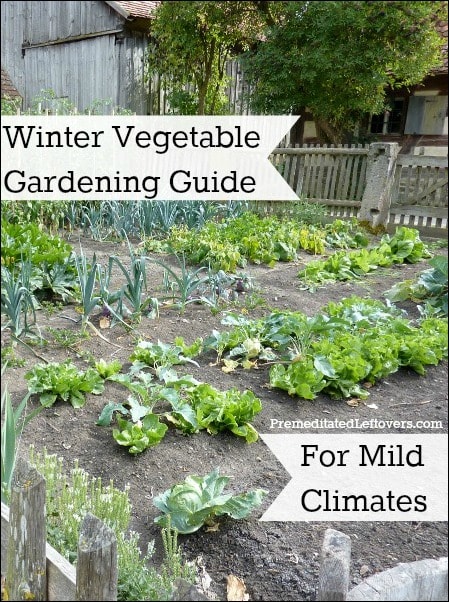Emily is sharing tips for growing vegetables in the winter in areas that have a mild winter:
During the winter months vegetable planting slows down as we prepare our gardens for hard freezes and rain. While doing so we watch the prices of fruit and vegetable rise to unrealistic proportions as our pocket book drains. Our pocket books don’t have to take a beating during this time of year if we plan right. Winter vegetable gardening can be done successfully with a little planning and preparation. Keep in mind that winter weather can vary from region to region so you need to check your hardiness zone to ensure you are planting the right plants for each season.
Winter Vegetable Gardening Guide for Mild Climates
First things first, if you have a greenhouse you have an advantage over those who don’t own one. A greenhouse is a wonderful thing to own but not everyone has the space or the money to buy one. If you have space and you can afford it I highly recommend the investment. There are “build it yourself Greenhouse kits” on Amazon that are fairly inexpensive. You can also build your own greenhouse out of bamboo using these instructions. Having a greenhouse means your crops are protected from frost. A heated greenhouse will create an appropriate atmosphere if you want to grow warm-weather crops.
Late planting of crops do well in climates that have a milder winter; crops won’t do well in places where winters go beyond negative degrees. The Pacific Northwest is an ideal climate for winter vegetables because the winters are mild. The environmental conditions of cool weather add sweetness and crispness to fall vegetables. Some of the Fall crops that do well in winter include Brussels sprouts, kale, parsley, radishes, spinach, some lettuces, Swiss chard, parsnips, carrots, onions, and beets. You can plant or carry over these vegetables from your fall harvest in late fall and expect an early winter harvest.
Vegetables that Grow Well in Cool Weather:
- garlic
- endive
- kale (How to Grow Kale)
- chicory
- carrots (How to Grow Carrots)
- Swiss chard (How to Grow Swiss Chard)
- broccoli (How to Grow Broccoli)
- cauliflower (How to Grow Cauliflower)
- cabbage (How to Grow Cabbage)
- beets (How to Grow Beets)
- radishes (How to Grow Radishes)
- turnips
- bush beans
- Brussels sprouts (How to Grow Brussels Sprouts)
- Chinese cabbage
- kohlrabi (How to Grow Kohlrabi)
- onions (how to grow larger onions)
- leeks
- chives
- mustard greens
- lettuces (How to grow gourmet lettuces.)
- peas (How to Grow Peas)
- artichokes
- fava beans
Managing Garden Pests During the Winter
Pest management during the winter months depends on the severity of weather conditions. For very mild winters you may actually see a worsening of insects attacking the beds. To treat winter insect attacks you want to use a softer insecticide such as a natural vinegar, pepper or garlic spray. Here are some homemade insecticide recipes you can make. Generally speaking, you won’t have an insect problem when it begins to ice over or snow. Just because insects are less of a problem after a freeze, doesn’t meant that other pests such as rabbits, deer, and squirrels will not be a problem. They actually may become more of a problem as other vegetation dies back. Here is a homemade rabbit repellent recipe and natural ways to repel deer, but you may need to protect your garden with appropriate fencing.
How to Protect Your Garden During a Freeze
With the proper tools and knowledge, preparing for the winter freeze is much easier than people think. All it takes is a quick eye to sense when a freeze or snow is coming and the right products to protect the plants.
Provide ground cover for vegetables in the winter. When carrying fall crops into the winter months you need to protect them from the cold, frost and icy rain. Straw, hay or burlap bags can be used as ground cover to protect the roots.
Use a cloche – You can make a frugal cloche with plastic milk jugs, soda bottles, cartons and large plastic fruit bowls. Just use them to cover the more delicate plants and act as a cloche to protect the plants from a freeze or snow. You can also place your crops in terracotta planters before planting in the ground to keep the roots warm during cold fronts.
If you are caught unaware, don’t give up hope. Snow can actually provide insulation and protection against severe freezes. Once the snow melts, cut away the damaged leaves and give it a chance before you dig it out. Spinach, beets, parsnips, onions, carrots, garlic, Swiss Chard, and kale have a very good chance of coming back and providing you will an early spring harvest.
Emily is passionate about growing her own food, crafts, sewing, developmental disabilities and blogging. You can find her blogging over at Emily’s Frugal Tips, a frugal blog dedicated to teaching families how to live with more for less money.


Troy Brooks says
Nice post on Winter gardening. I would also like to share another post on the subject concerning Fall Gardening as it’s right inline with what you wrote. The link is at:http://www.myheirloomseeds.com/fall_gardening.php
Happy Gardening!